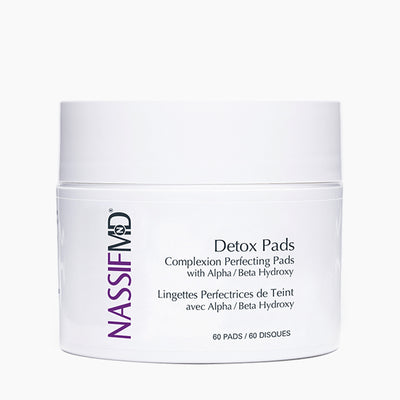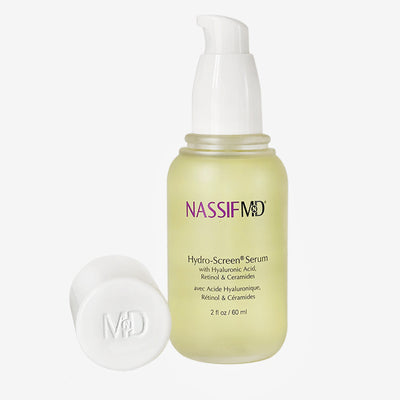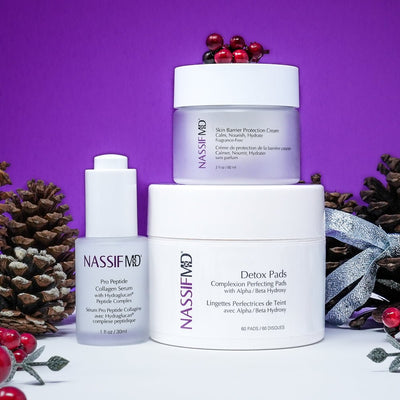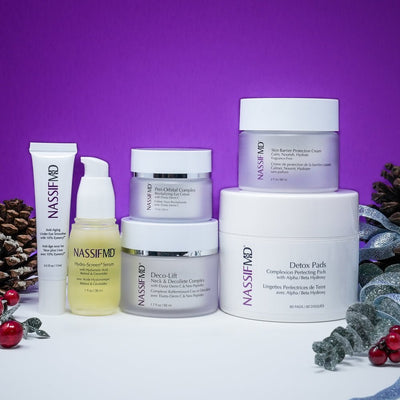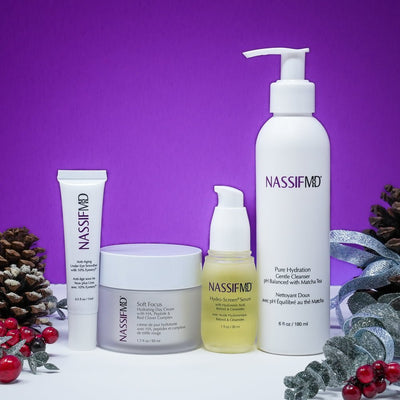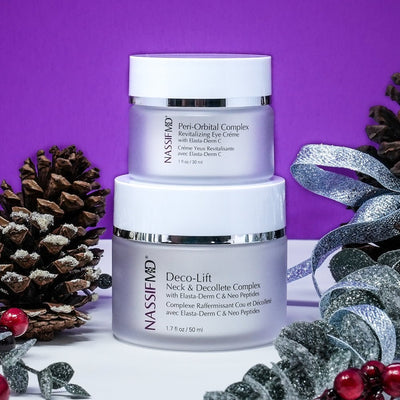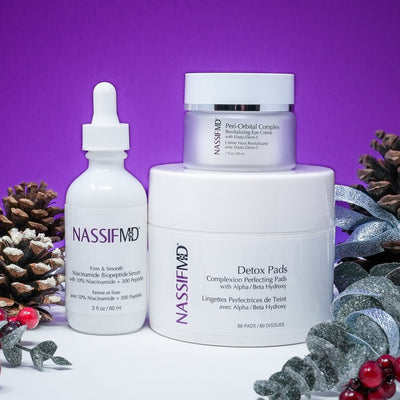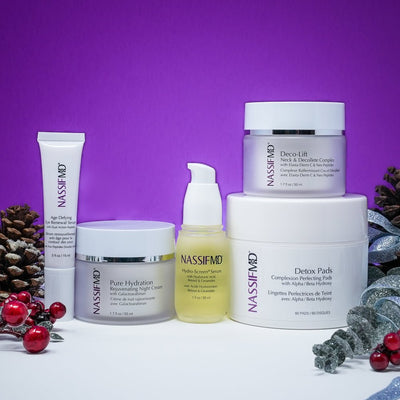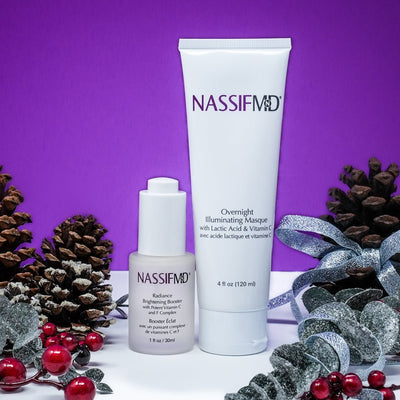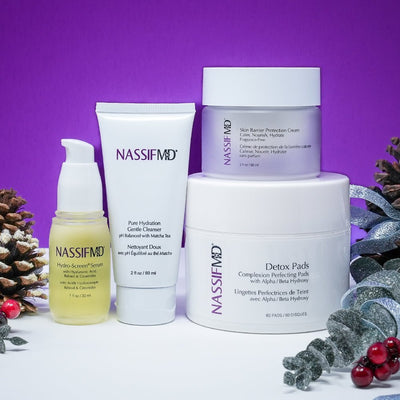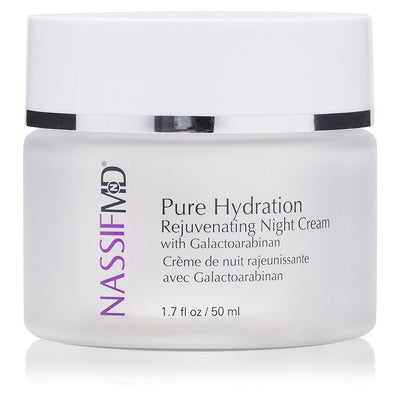What Order to Apply Skincare
Healthy, glowing skin isn’t just about using the best skincare products; it also requires attention to the skin routine order. Correctly layering skincare products allows the skin to absorb active ingredients and enhances the results.
A good rule of thumb for your skincare routine order is to layer from the thinnest, lightweight products to increasingly thicker products. Finish with occlusive formulas to seal in the lighter ones.
Whether you follow a basic skincare routine or enjoy more steps, the skincare order matters. The process doesn’t need to be complicated, but with so many different skincare products available, questions arise. Today’s article will walk you through the skincare routine steps you can choose from when building your face routine.
Keep reading as we discuss each step:
- Skin cleanser (plus how to exfoliate)
- Toner
- Spot treatment
- Skin serum and antioxidant serum
- Eye cream
- Best facial moisturizers
- Face oil
- Sunscreen
Skincare Routine Steps
The order of skincare products helps determine the effectiveness of the routine. You don’t need a 10-step routine, as each of these steps may not fit your skin’s needs, but the order of application is the same: start with cleansing and toning and move from lightweight serums to thicker moisturizing products. During the day, finish with sunscreen before makeup.
Further, understanding the skincare routine order and the importance of various quality products helps build confidence and provides better compliance when addressing skin concerns.
Cleanser
The first step in any skin routine is always cleansing. By washing away dirt, oil, makeup, and debris, a good cleanser helps to create a clean slate for what follows in a skincare routine.
Cleansing is genuinely an art. Beyond the practical aspects of using a cleanser to clean and often exfoliate, cleansing can become a relaxation ritual and a simple way to practice self-care.
How to Choose the Right Cleanser for You
With so many cleanser options, choosing a quality product for your skin type is important. Also, decide if you want your cleanser to double as an exfoliating scrub. Exfoliation removes dead skin cells and impurities that can clog pores, but how much face exfoliating you can handle will depend on your skin type and the strength of the product you choose. Some will exfoliate daily, while others do better with only a few times weekly. In that case, you may need two products to rotate.
NassifMD® facial plastic surgeon skincare offers cleansers to meet your needs:
- NassifMD® Pure Hydration Facial Cleanser – A gentle, hydrating cleanser for everyday use without dryness or irritation. It’s an excellent fit for all skin types, including mature and sensitive skin.
- NassifMD® Purifying Glycolic Facial Cleanser – This cleanser doubles as a gentle exfoliator with non-drying alpha hydroxy acids. It cleanses while brightening the skin to restore a youthful look.
- NassifMD® Detox Facial Pads – For deep cleaning and exfoliation, use these pads in addition to your cleanser or in place of a cleanser when you’re on the go. Adjust the frequency of use to your skin type, starting with a couple times per week.
Toner
Using a skin toner is the second step in the order of skincare. While this step is optional, it’s highly recommended. A quality toner will help remove the last of the impurities after cleansing and restore the skin’s healthy pH level.
What Are the Different Types of Toner?
You’ll find facial toners on the market that contain hydroxy acids for an exfoliating toner or astringents like witch hazel, which is good for oily or acne-prone skin. A hydrating toner benefits all skin types and what you’ll find with NassifMD® Skincare. Choose from:
- NassifMD® 3HA Hydrating Facial Mist – With three types of hyaluronic acid, this toner optimizes hydration and nourishes the skin. You’ll see instant plumping, calming, and soothing effects.
- NassifMD® Pure Hydration Replenishing Toner – Balance, hydrate, and calm the skin with hyaluronic acid and anti-inflammatory toning ingredients.
Spot Treatments
After cleansing and toning, the next step in the skincare order is to address problem areas as needed. While an acne spot treatment may be the most well-known spot treatment, you can also apply targeted treatments to dark patches, areas of eczema, and other confined issues. If you don’t need any spot treatments, move on to serums.
Serums
Serums are lightweight, fast-absorbing products with concentrated active ingredients such as specific antioxidants. They target specific skin issues, such as brightening, anti-aging, hydrating, etc.
While you may only choose one serum, you can layer serums for multiple benefits and use different serums in your morning and evening routines.
What Active Ingredients to Look For
Some examples of concentrated active ingredients in NassifMD® Skincare include retinol, hyaluronic acid, and vitamin C.
Retinol
Retinol is an active form of vitamin A and a component of antioxidant face serums. It’s well-studied for its anti-aging and anti-wrinkle benefits and works by improving skin turnover and collagen production.
Hyaluronic Acid
Hyaluronic acid is a natural molecule found throughout the body, notably the skin and joints. The topical application of hyaluronic acid pulls moisture into the skin and holds it there, making it one of the most potent hydrating ingredients. It also supports skin regeneration and has anti-inflammatory and anti-aging benefits.
Vitamin C
Vitamin C is another powerful antioxidant in facial serums. It protects the skin from free radicals caused by sun damage and pollution. Additionally, it helps fade areas of hyperpigmentation and brightens the skin.
Choose from these NassifMD® serums, or incorporate several for healthy, radiant skin:
Eye Cream
After serums, support the delicate eye area with an eye cream. This step is optional but also recommended because the eye area is often the first to show signs of dehydration, sun damage, and aging.
Choose from these best eye cream options:
- NassifMD® Age Defying Eye Renewal Serum – Target the entire eye area with this peptide-rich eye serum.
- NassifMD® Peri-Orbital Eye Complex – This eye cream utilizes vitamin C and antioxidants to tighten and firm the skin around the eyes while revitalizing the skin.
- NassifMD® Undereye Anti-Aging Smoother – This is the best undereye cream for reducing puffiness and wrinkles by building collagen and improving hydration.
Moisturizer
The next step in your skincare routine is moisturizer. Moisturizers have a thicker consistency than the prior products used in your routine. They support the protective functions of the skin barrier and improve the moisture content of the skin.
Importance of Sealing in Moisture
Water is lost through the skin and evaporates. This transdermal water loss contributes to skin dehydration, fine lines, and wrinkles. Restoring moisture is an essential objective with any skincare routine. Many previous skincare steps address hydration, but a moisturizer is necessary for sealing the moisture in and creating a barrier so it can’t escape.
Choose from these NassifMD® moisturizers:
- NassifMD® Soft Focus Hydrating Day Cream – Promotes plump, glowing skin all day with instant perfecting results!
- NassifMD® Pure Hydration Night Cream – This is the best moisturizer for nighttime use, giving meaning to the phrase “beauty sleep” as it plumps, hydrates, and repairs overnight.
- NassifMD® Hydro-Screen Souffle – Intensely hydrate and nourish the face and body to smooth wrinkles and improve radiance.
Face Oil
For those who need extra moisturization beyond their moisturizer, add a facial oil afterward to support the skin barrier further. This step isn’t for everyone, but it is suitable for those with dry skin or who need extra moisturizing in the winter. Choose products containing natural oils like jojoba, sunflower, argan, and coconut. NassifMD® Skin Barrier Balm has a sunflower oil base and can be used like a facial oil for hydration and protection.
Sunscreen (Morning)
While a moisturizer or face oil is the last step of the evening skincare routine, in the morning, you’ll need one more product: sunscreen. Sunscreen is a non-negotiable product for everyday use, not just when going to the beach or outside in the summer. Choose a product with SPF 30 or higher and apply it to the face and all other exposed skin areas.
NassifMD® Skincare offers an effective line of safe, mineral-based sun protection. Choose NassifMD® Protect & Hydrate for a tinted hydrating sunscreen (SPF 44) or NassifMD® Simply Hydration (SPF 40) for an un-tinted option.
The best skincare routine is the one that works for you. Whether you enjoy a simple 4-step routine or use multiple serums and enjoy a longer process, the order in which you apply your products is critical. Get the most from your active ingredients and see enhancements in your skin health when you follow the order of application described here and use quality products from NassifMD® Skincare.
References
- Goh, C. L., Wu, Y., Welsh, B., Abad-Casintahan, M. F., Tseng, C. J., Sharad, J., Jung, S., Rojanamatin, J., Sitohang, I. B. S., & Chan, H. N. K. (2023). Expert consensus on holistic skin care routine: Focus on acne, rosacea, atopic dermatitis, and sensitive skin syndrome.Journal of cosmetic dermatology, 22(1), 45–54.
- Mukhopadhyay P. (2011). Cleansers and their role in various dermatological disorders.Indian journal of dermatology, 56(1), 2–6.
- Zasada, M., & Budzisz, E. (2019). Retinoids: active molecules influencing skin structure formation in cosmetic and dermatological treatments.Postepy dermatologii i alergologii, 36(4), 392–397.
- Juncan, A. M., Moisă, D. G., Santini, A., Morgovan, C., Rus, L. L., Vonica-Țincu, A. L., & Loghin, F. (2021). Advantages of Hyaluronic Acid and Its Combination with Other Bioactive Ingredients in Cosmeceuticals.Molecules (Basel, Switzerland), 26(15), 4429.
- Elhabak, M., Ibrahim, S., & Abouelatta, S. M. (2021). Topical delivery of l-ascorbic acid spanlastics for stability enhancement and treatment of UVB induced damaged skin.Drug delivery, 28(1), 445–453.


